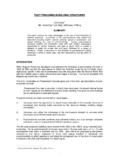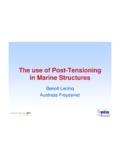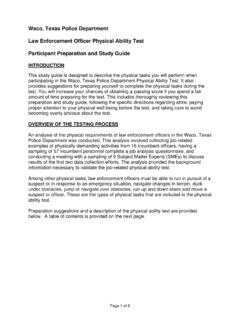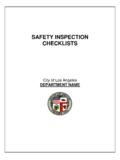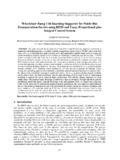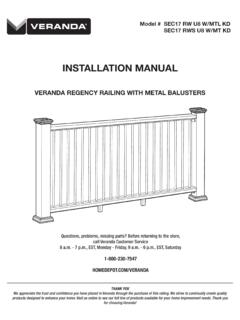Transcription of FUTURE SLAB PENETRATIONS and DEMOLITION …
1 FUTURE slab PENETRATIONS and DEMOLITION of post - tensioned FLOORS FUTURE slab PENETRATIONS and DEMOLITION of post - tensioned floors INTRODUCTION post - tensioned floor slabs in Australia and South East Asia are now universally regarded as the most cost effective form of construction for shopping centres, office buildings, and carparks where spans exceed metres. The preferred post -tensioning system used is the well proven `bonded' tendon utilising from 3 to 5 individual prestressing strands housed in oval ducting and anchored in flat fan shaped anchorage castings.
2 A question often asked of post - tensioned slab systems is what happens if we wish to make a penetration in the slab after construction. From time to time it has been brought to our attention that certain members of the building profession see this question as a major obstacle and are reluctant to accept the use of prestressing in some types of buildings. This is often due to a perceived lack of flexibility in the structure when it comes to the formation of openings through the slabs some time after construction. This report will outline the options available to enable the designer to produce a building which is both economic to construct and easy to modify in the FUTURE .
3 PLANNING FOR OPENINGS Possible FUTURE Requirements There is no doubt that during the lifetime of a structure the requirements of a tenant may alter with time or the tenant may change several times. Each new tenant will have his own requirements for mechanical, hydraulic and electrical services, as well as loading arrangements and general layout. Therefore, for a building to remain readily lettable in the FUTURE it must have the flexibility to accommodate openings for stairs, services or lifts, and the possibility for changes in loading patterns. Choice of Building System No building system can be infinitely flexible in terms of FUTURE tenant requirements.
4 Whether a slab is constructed from post - tensioned concrete, pre-cast concrete, structural steel or insitu reinforced concrete there will be certain areas such as main beam strips where holes cannot be accepted without significant difficulty. Overall Structural adequacy Whatever the building system and material, it is important to locate the new opening with due regard to the structural stability of the remaining portion of slab . The Structural Engineer must check the penetration location and advise any remedial work required, such as trimming beams, regardless of the structural system.
5 A post - tensioned slab will have similar strengths and weaknesses in terms of its flexibility as FUTURE slab PENETRATIONS and DEMOLITION of post - tensioned floors insitu reinforced concrete. For example, if a new stair well were to be located in the centre of a panel such that short cantilever slabs were retained on all sides to counterbalance the adjacent bays, it is quite possible that no additional supporting members would be required. A precast system or steel framed structure may require the removal of the whole panel, construction of trimmer beams around the new void, and replacement of the slab to the surrounding edges.
6 DESIGNING post - tensioned SLABS FOR FUTURE OPENINGS Locating post -tensioning tendons For post - tensioned slabs and beams where tendon positions may not be readily identifiable, soffit marking can be employed. Prior to casting the slab , stainless steel staples are use to secure the ducts to the formwork. When the formwork is struck, the position of the tendons is obvious, especially if the staple lines have been linked by painted lines. Alternatively, chalk lines can be marked on the slab top surface to aid in the locating of post -tensioning tendons. These procedure will assist in locating openings away from tendons.
7 Structural systems in post - tensioned concrete Band Beam and slab For rectangular grids the band beam and slab solution may be appropriate. This is the system typically used for shopping centres and carparks due to the economic benefit and relative insensitivity to floor height restrictions. Normally band beams span in the long direction and impose the same constraints on hole placement as would a steel or reinforced concrete beam. However, small hydraulic type PENETRATIONS (approximately 150 mm diameter) can usually be accommodated without the need for remedial action.
8 The slabs however, are usually quite lightly prestressed with tendons in one direction only at approximately 1500 mm centres. Reasonable size openings or large slots are therefore easy to accommodate without the need to cut post -tensioning tendons. Flat Slabs and Flat Plates For structures requiring minimum floor to floor height and regular grids the two-way post - tensioned flat slab is usually the most cost effective solution. The normal installation procedure would concentrate the tendons into `column strips' along the column grids at approximately 600 mm centres with tendons away from the column strip at approximately 1400 mm centres.
9 Consequently small holes for services could be located without the need to cut tendons. Using this structural system it is possible to leave the central panel as traditionally reinforced FUTURE slab PENETRATIONS and DEMOLITION of post - tensioned floors and designed as a `soft zone' to easily accommodate large openings. The cost penalty for the extra reinforcement required would need to be offset against the perceived benefits. Ribbed and Waffle slab Larger grids or heavier loads may dictate the introduction of ribs spanning either one-way or two-way (waffle) depending upon the aspect ratio of the grid.
10 Rib spacings for post - tensioned slabs are generally larger than for reinforced concrete, being typically to metres. Consequently small to moderate holes can easily be cut through the topping slab without disturbing the ribs. Indeed with tendons confined to the ribs their location is readily identifiable, assisting in the siting of the openings. CUTTING OF TENDONS Bonded Tendons Bonded tendons are located within oval shaped galvanised ducts which are injected with cement grout following the post -tensioning procedure. Consequently when such a tendon is severed, the free end will become de- tensioned but after a short transmission length the full tendon force will be effective.



